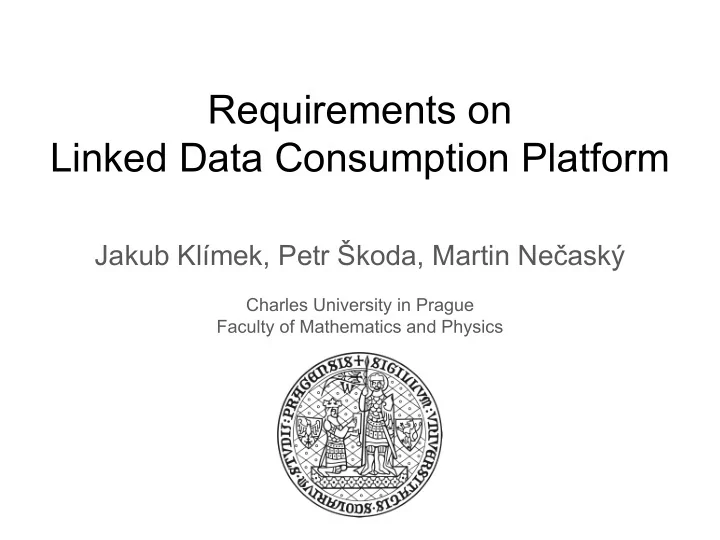

Requirements on Linked Data Consumption Platform Jakub Klímek, Petr Škoda, Martin Nečaský Charles University in Prague Faculty of Mathematics and Physics
Motivation: The 4th star problem “As a consumer , you can do all what you can do with *** Web data … “ 1. Is this really true? ○ Can I really do all what I could with my CSVs and XMLs? ○ Download it, open it, see what is inside, use it as I could with an Excel file? 2. Who is the consumer here? ○ RDF & LD enthusiasts? ○ Journalists, app developers, academics ○ Regular IT people? 2
Motivation: The 4th star problem <https://data.cssz.cz/resource/observation/prehled-o-celkovem-poctu-osvc-podle- kraju/2010-03-31/VC.19/dobrovolne-dp/> a qb:Observation ; cssz-dimension:datum <https://data.cssz.cz/resource/reference.data.gov. uk/id/gregorian-day/2010-03-31> ; cssz-dimension:kraj <https://data.cssz.cz/resource/ruian/vusc/19> ; qb:measureType cssz-measure:dobrovolne-dp ; cssz-measure:dobrovolne-dp 59 ; qb:dataSet cssz-dataset:prehled-o-celkovem-poctu-osvc-podle-kraju . <https://data.cssz.cz/resource/observation/prehled-o-celkovem-poctu-osvc-podle- kraju/2010-03-31/VC.19/dobrovolne-np/> a qb:Observation ; cssz-dimension:datum <https://data.cssz.cz/resource/reference.data.gov. uk/id/gregorian-day/2010-03-31> ; cssz-dimension:kraj <https://data.cssz.cz/resource/ruian/vusc/19> ; qb:measureType cssz-measure:dobrovolne-np ; cssz-measure:dobrovolne-np 13940 ; qb:dataSet cssz-dataset:prehled-o-celkovem-poctu-osvc-podle-kraju . 3
Motivation: The 4th star problem 4
Motivation: The 4th star problem A bit unfair, something like showing the insides of an Excel file <?xml version="1.0" encoding="UTF-8" standalone="yes"?> <worksheet xmlns="http://schemas.openxmlformats. org/spreadsheetml/2006/main" xmlns:r="http://schemas.openxmlformats. org/officeDocument/2006/relationships" xmlns:mc="http://schemas. openxmlformats.org/markup-compatibility/2006" mc:Ignorable="x14ac" xmlns:x14ac="http://schemas.microsoft. com/office/spreadsheetml/2009/9/ac"><dimension ref="A1:B3" /><sheetViews><sheetView tabSelected="1" workbookViewId="0" /></sheetViews><sheetFormatPr defaultRowHeight="15" x14ac:dyDescent=" 0.25"/><cols><col min="1" max="2" width="10.7109375" bestFit="1" customWidth="1"/></cols><sheetData><row r="1" spans="1:2" s="1" customFormat="1" x14ac:dyDescent="0.25"><c r="A1" s="1" t="s" ><v>1</v></c><c r="B1" s="1" t="s"><v>0</v></c></row><row r="2" spans=" 1:2" x14ac:dyDescent="0.25"><c r="A2" t="s"><v>2</v></c><c r="B2" ><v> 1247000 </v></c></row><row r="3" spans="1:2" x14ac:dyDescent="0.25" ><c r="A3" t="s"><v>3</v></c><c r="B3" ><v> 1650000 </v></c></row></sheetData><pageMargins left="0.7" right="0.7" top="0.75" bottom="0.75" header="0.3" footer="0.3"/><pageSetup paperSize="9" orientation="portrait" horizontalDpi="4294967294" verticalDpi="0" r:id="rId1"/></worksheet> 5
Motivation: Unmet expectations ● 4* are better that 3*. But for whom? ○ Grandma can open an Excel file. Can she open RDF? ○ Try uploading RDF files to Google drive ● Is this how it is supposed to be? ○ No! ○ There are standards ■ Discovery: DCAT, DCAT-AP ■ Syntax: RDF and serializations ■ Access: HTTP, SPARQL ■ Modelling: SKOS, DCV, ... ○ Missing: Tools ● What do the tools need to do to ○ Facilitate LOD consumption ○ Demonstrate the LOD benefits to consumers ● => 40 Requirements on Linked Data Consumption Platform (LDCP) 6
3 requirements: Dataset discovery 1. Catalog support ○ CKAN API, DCAT-AP 2. Advanced discovery ○ Dataset indexing, such as Sindice, but possibly more advanced 3. Context-aware discovery ○ Recommendation of other relevant datasets based on the ones already selected for work 7
6 requirements: Data input 4. IRI dereferencing ○ Basic principle of Linked Data 5. RDF dump load ○ Turtle, RDF/XML, N-Triples, N-Quads, TriG, JSON-LD, RDFa 6. SPARQL querying ○ SELECT, CONSTRUCT, DESCRIBE, ASK 7. Linked Data Platform input ○ LDP Containers 8. Non-RDF data input ○ CSV, XML, JSON 9. Monitoring of input changes ○ Notifications, pipelines triggering 8
6 requirements: Dataset preview 10. Preview - W3C vocabularies ○ SKOS, ORG, DCV 11. Preview - LOV vocabularies ○ DCTERMS, GoodRelations, Schema.org, FOAF, vCard 12. Preview metadata ○ DCAT, DCAT-AP, VoID descriptions of datasets 13. Preview data ○ Statistics, description of datasets based on the actual data 14. Preview schema ○ Can be extracted using SPARQL queries 15. Quality indicators ○ Help users to decide whether to use a dataset or not ○ E.g. schema coverage, temporal coverage, geographical coverage, … 9
2 requirements: Analysis of semantic relationships 16. Semantic relationship analysis ○ Datasets interlinked? ○ Shared resources? ○ Temporal/geographic coverage overlapping? ○ ... 17. Semantic relationship deduction ○ Link discovery - SILK ○ Ontology matching ○ ... 10
7 requirements: Data manipulation 18. Vocabulary-based transformations ○ E.g. means of translating from FOAF to Schema.org, from WGS84_pos to Schema.org etc. 19. Vocabulary alignment ○ Possible semantic overlaps, suggest a transformation - ontology alignment 20. Inference ○ Inference rules, RDFS, OWL 21. Resource fusion ○ owl:sameAs, conflict resolution 22. Assisted selection and projection ○ SPARQL SELECT and FILTER or other means, graphically assisted 23. Custom transformations ○ Typical SPARQL 24. Automated data manipulation ○ Automatic transformation pipeline discovery based on some requirements 11
2 requirements: Provenance and license management 25. Provenance ○ Record and provide provenance data (PROV-O) 26. License management ○ https://github.com/theodi/open-data-licensing/blob/master/guides/licence-compatibility.md 12
9 requirements: Data output and visualization 27. Manual visualization ○ User specifies, what should be in the data 28. Vocabulary-based visualization ○ Data is analyzed, visualization offered based on vocabularies 29. RDF dump output ○ Turtle, RDF/XML, N-Triples, N-Quads, TriG, JSON-LD, RDFa 30. SPARQL Update output ○ INSERT DATA 31. SPARQL Graph Store HTTP Protocol output ○ HTTP GET, HTTP PUT, HTTP DELETE, HTTP POST 32. Linked Data Platform output ○ LDP Containers 33. Tabular data output ○ SPARQL SELECT + CSV on the Web JSON-LD metadata 34. Tree-like data output ○ RDF/XML, JSON-LD or better support of mapping 35. Graph data output 13 ○ Gephi, for images of graphs and linkage
5 requirements: Developer and community support 36. API ○ APIs used by LDCP should be well-documented, standardized (REST) and usable by everyone 37. RDF configuration ○ Need for configuration generation, best using one language - SPARQL 38. Repositories for sharing ○ Sharing of plugins (Eclipse, …) 39. Project reuse ○ Sharing of reusable parts of consumption projects (GitHub) 40. Deployment of services ○ When output is data, enable getting it/refreshing it through API 14
Our related efforts @ Charles University in Prague ● LinkedPipes ETL ○ Preparation and publication of RDF ○ Successor to UnifiedViews ● LinkedPipes Visualization ○ Vocabulary-based discovery of visualization pipelines ○ Successor to Payola and LDVMi ● Both going to be presented @ ESWC 2016 Demo Track, Crete, Greece Thank you for your attention klimek@opendata.cz @jakub_klimek 15
Recommend
More recommend